CO2 emissions (metric tons per capita)
Carbon dioxide (CO2) is a colorless gas that occurs naturally in Earth's atmosphere as a trace gas. Natural sources include volcanoes, hot springs and geysers. It is also a byproduct of fossil fuel combustion, biomass burning, land use changes and other industrial processes. The Burning of carbon-based fuels has rapidly increased concentrations of atmospheric CO2, increasing the rate of global warming and causing anthropogenic climate change.
This interactive map shows the CO2 emissions in metric tons per capita from 1960 to 2014. The data only include carbon dioxide emissions from the burning of fossil fuels and cement manufacture, but not emissions from land use. See the video below for an animation showing the changes through the years and check out the interactive version to explore the data in more detail.
The data comes from the Carbon Dioxide Information Analysis Center and Oak Ridge National Laboratory and is available from the World Bank website, where it is described as:
Statistical Concept and Methodology: Carbon dioxide emissions, largely by-products of energy production and use, account for the largest share of greenhouse gases, which are associated with global warming. Anthropogenic carbon dioxide emissions result primarily from fossil fuel combustion and cement manufacturing. In combustion different fossil fuels release different amounts of carbon dioxide for the same level of energy use: oil releases about 50 percent more carbon dioxide than natural gas, and coal releases about twice as much. Cement manufacturing releases about half a metric ton of carbon dioxide for each metric ton of cement produced. Data for carbon dioxide emissions include gases from the burning of fossil fuels and cement manufacture, but excludes emissions from land use such as deforestation.
Published on September 24, 2019 by Ramiro Gómez (@yaph). To be informed of new posts, subscribe to the RSS feed.
Tags: climate change, d3, environment, global warming, map, world, worldbank.
